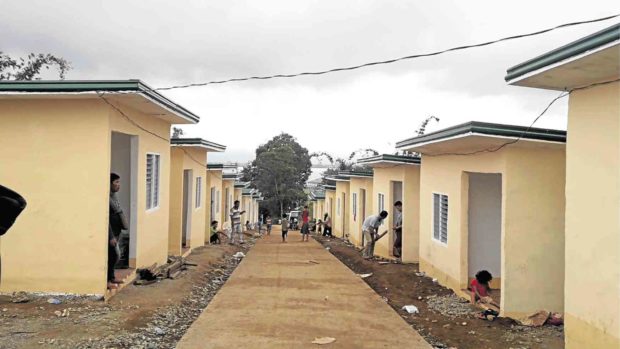In Marawi, 550 houses ready for families displaced by siege

NEW HOME More than 200 families who lost their houses during the five-month Marawi City siege in 2017 are starting anew in transitory shelters provided by the government in Boganga village. —DIVINA M. SUSON
MARAWI CITY — The National Housing Authority (NHA) has turned over 550 units of transitory shelters at Barangay Boganga here to families who lost their homes during the five-month war between government forces and Islamic State-inspired armed groups in Marawi City in 2017.
The first batch of beneficiaries, consisting of 206 families, had settled into their units after the turnover ceremony last week. The NHA said the remaining units were unoccupied as beneficiaries would have to be identified by the city government.
The relocation site, known as Lake View Shelter, is the second put up for displaced families in Marawi, particularly those from villages comprising the 250-hectare “ground zero,” which bore the brunt of heavy bombardment during the siege.
‘Bahay ng Pagbabago’
These families had stayed in different evacuation centers in the provinces of Lanao del Sur and Lanao del Norte.
Article continues after this advertisementThe government earlier built 1,052 temporary shelters in the first relocation site at Barangay Sagonsongan, known as Bahay ng Pagbabago, where all units had already been occupied by beneficiaries.
Article continues after this advertisementInside the Sagonsongan site, Angat Buhay Village, sponsored by Vice President Leni Robredo’s Angat Buhay Foundation, offered 60 houses to beneficiaries who had earlier been identified.
The NHA said 1,500 more temporary houses would be built in Boganga, 300 of these would be turned over before the end of March to residents who were still staying in evacuation centers.
Roderick Ibañez, NHA director, said the government had completed building the houses in Boganga in less than five months.
Poor conditions
Salima Ampaso, a former resident of Barangay Datu Naga, one of the villages inside Marawi’s ground zero, said she was relieved to be included in the first batch of beneficiaries at the Boganga site, noting her family had been enduring poor living conditions in the evacuation center.
“It was too hot at the evacuation center and you don’t have any privacy. You cannot move to earn a living because if you leave, nobody would watch your tent and you worry about the safety of your children,” said Ampaso, who had stayed in an evacuation center outside the city for two years.
The government’s Task Force Bangon Marawi said displaced families still living in evacuation centers outside Marawi were given priority in transitory shelters built for residents from ground zero.
Living in tents
Around 800 families are still living in evacuation centers more than a year after the siege ended in October 2017.
According to the NHA, families living in tents, such as those in a site called Sarimanok at Barangay Poblacion, will be given houses once the government completes the distribution of units to displaced residents from ground zero.
Records from the Department of Social Welfare and Development showed that more than 300 families were staying in tents at Sarimanok.